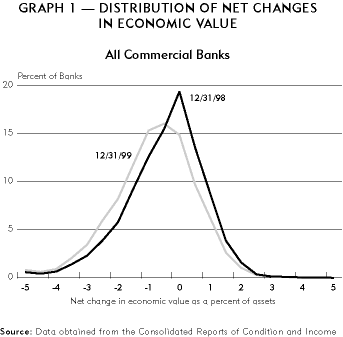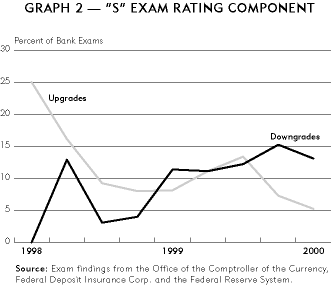Editor's Note: As the savings and loan crisis of the 1980s showed, taxpayers can end up paying when banks engage in excessive risk taking. And there are a large number of ways that banks can take on too much risk. They might make speculative loans, for example. The savings and loan industry engaged in speculative lending but also was exposed to risks by making long-term mortgages that were funded by short-term deposits. This creates what is called interest rate risk, which is discussed below in more detail. It is clear why taxpayers should care about bank risk taking, but why should the Federal Reserve?
As one of its duties, the Fed regulates the safety and soundness of certain banking organizations. This means the Fed monitors the riskiness of these banking organizations, examines them and takes steps to prevent them from taking risk in excessive levels. As a result, the Fed has a strong interest in topics such as interest rate risk. The Minneapolis Fed not only devotes considerable resources to regulating banks, but it also gives serious attention-in the fedgazette and other publications—to the effect of regulatory policy on bank risk taking.
All banks face interest rate risk (IRR) and recent indications suggest it is increasing at least modestly. Although IRR sounds arcane for the layperson, the extra taxes paid after the savings and loan crisis of the 1980s suggests there is good reason to learn at least a little about IRR.
Think of IRR as blood pressure for banks. It can increase or decrease without obvious outward signs, and such changes can cause failure. At the same time, regulators and banks can monitor it and detect changes. Finally, banks can take preventative steps to manage IRR but they do not want to eliminate it completely as it, like blood pressure itself, is vital for survival.
In general, IRR is the potential for changes in interest rates to reduce a bank's earnings and lower its net worth. IRR manifests in several different ways but we will provide a simplified example to illustrate the general issue. The most common manifestation of IRR occurs because the assets of the banks, such as the loans it holds, come due or mature at a different time than the liabilities of the bank, such as deposits.
Take, for example, a bank that funds itself only with certificates of deposit that have a maturity of two years. This bank also only makes mortgage loans with a maturity of 15 years. Should interest rates rise in the future, the bank would face a decline in its expected income. Why? The monthly inflow of cash to the bank from the mortgages are fixed for 15 years. When the certificates of deposit come due before the mortgages, the bank will have to pay more to receive funding so cashflows out of the bank will increase.
Clearly IRR holds the potential to have a negative impact on earnings and net worth of a bank. So why don't banks try to eliminate it by ensuring that all of its assets and liabilities have exactly the same maturities? Banks would earn less money without taking on this risk. By earning the difference between long-term and short-term rates, for example, banks are getting paid to assume IRR and meet the demands of customers for deposits and loans. The challenge for banks is to measure IRR and manage it such that the compensation they receive is adequate for the risks they incur.
Focusing on risk management of banks in this case is particularly important because, as has been pointed out in many Minneapolis Fed publications, some of the risk taking of banks is borne by the taxpayers who support the safety net for banks. These concerns are always heightened in periods such as the current one where IRR is on the rise.
Measurements of interest rate risk: Going up
Regulators and banks employ a variety of different techniques to measure IRR.A relatively simple method used by many community banks is gap analysis, which involves grouping assets and liabilities by their maturity period, or the time period over which the interest rate will change (the "repricing period"), such as less than three months, three months to one year, etc. The "gap" for each category is then expressed as the dollar value of assets minus liabilities. A large, negative gap would indicate that the bank has a greater amount of liabilities that are repricing during that time than assets, and therefore would be exposed to an increase in rates. A negative gap would suggest an exposure to a decline in rates.
Regulatory agencies often employ a slightly more complex version of gap analysis to estimate the level of IRR for a bank and for the entire banking industry. This technique involves estimating the change in the value of assets and liabilities within each time band at a given institution for a change in interest rate (for example, up 2 percentage points) and then calculating the aggregate difference between the two. This amount roughly represents the loss in net worth a bank would suffer if interest rates moved unexpectedly.
Consider a hypothetical bank with $80 million in assets, $60 million of it in liabilities and $20 million in equity capital. Following a 2 percentage point increase in interest rates, the asset value of the bank drops to $70 million while the value of liabilities falls to $55 million. The change in net worth for this bank would be negative $5 million, implying that equity capital is worth only $15 million. Typically, the net change in economic value is expressed as a percentage of assets.
Graph 1 below shows the distribution of changes in economic value for an immediate 2 percentage point increase to interest rates for all commercial banks in the nation at the end of 1999 and 1998. The distribution has shifted to the left from year-ago levels, suggesting that IRR has increased for the industry.

For example, in December 1999 the percentage of banks whose economic value would decline by more than 1.5 percent of assets increased from 25 percent to 33 percent. Ninth District banks have witnessed similar shifts in their distribution over the past year, although the aggregate levels are lower. Currently, 24 percent of banks within the district would see their economic value shrink by more than 1.5 percent given a 200 basis point increase in rates, compared to just 13 percent one year ago.
These results are reinforced by findings from recent bank examinations. In addition to assessing things like capital adequacy, asset quality and earnings performance, regulators also rate the sensitivity of a bank to market risk arising from their exposure to foreign exchange, commodities, equities, and interest rates. (For more information on examination ratings see the January 1999 fedgazette article, "What Are CAMELS and Who Should Know.")
While the vast majority of commercial banks in the nation received one of the two highest ratings, the percentage of banks whose sensitivity ratings were downgraded from their last exam has been climbing steadily, and actually exceeded the percentage of banks that were upgraded during the last two quarters (see graph 2). Similar results are found in Ninth District exam ratings.

Two likely culprits behind the recent increases in IRR at commercial banks are lengthening asset maturities and a greater reliance on short-term, volatile liabilities. Banks have changed the composition of their asset portfolios to include larger holdings of both residential mortgages and mortgage-related securities, two asset categories that typically have longer maturity periods. Additionally, the percentage of such assets that mature or reprice in less than one year has been declining in favor of assets that mature in over 15 years.
At the same time that their asset portfolio maturity has been rising, banks have been forced to rely more heavily on volatile liabilities due to sluggish deposit growth. Examples of volatile liabilities include fed funds purchased, other borrowed monies (like advances from the Federal Home Loan Banks), and time deposits over $100,000. These instruments typically mature in a very short period (often under a year), exposing banks to higher interest expenses if market rates are rising when these funds are being replaced. Together, these trends are resulting in the asset side of the balance sheet becoming less interest-sensitive while the liability side is becoming more sensitive.
Response to heightened levels of interest rate risk
Commercial banks can take several steps to manage IRR. The first step in management is measurement. In addition to some of the techniques described above, banks have much greater access over the last several years to advanced forms of computer models that allow them to determine their IRR on a real-time basis.
Banks can also avail themselves of asset/liability management firms to get expert advice on controlling their IRR. In addition to directly changing the types of assets and liabilities they hold, banks can enter into financial contracts to shift some of the IRR they have to other parties who are better able to manage it. Finally, regulators closely scrutinize the systems used by bank managers to measure and identify their interest rate risk to ensure that banks are not taking on undue levels of such risk.






